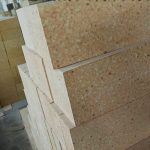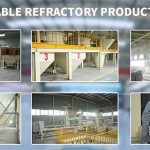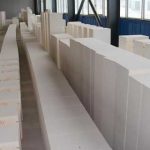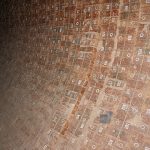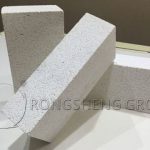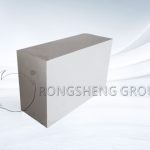Silica bricks are the most commonly used and important brick type in various types of glass kilns. Silica bricks are mainly used in the roof, breast wall, end wall, small furnace, and regenerator roof of the upper space of the glass melting furnace. The raw materials for producing silica bricks are mainly crystalline quartzite, with a small amount of iron oxide and calcium oxide added as mineralizers. To promote tridymite transformation as completely as possible and keep it fired in a stable temperature range. The SiO2 content of silica bricks is 93% as the lower limit, and high-end products are 96% to 98%.
High-Quality Silica Bricks for Glass Kiln
Silica bricks have high high-temperature structural strength, such as a high load softening point (1640~1700℃) and low creep rate [1550℃-50h-0.2MPa-(6~7)×10-5]. Moreover, after absorbing a small amount of alkaline components, the strength of the kiln roof structure will not be reduced except for very slight corrosion.
The main disadvantage of silica bricks is their low thermal shock resistance. The firing of silica bricks is a key link in the entire silica brick production process. During firing, we must strive to complete the phase change process to the maximum extent to form an ideal microstructure and have better performance.
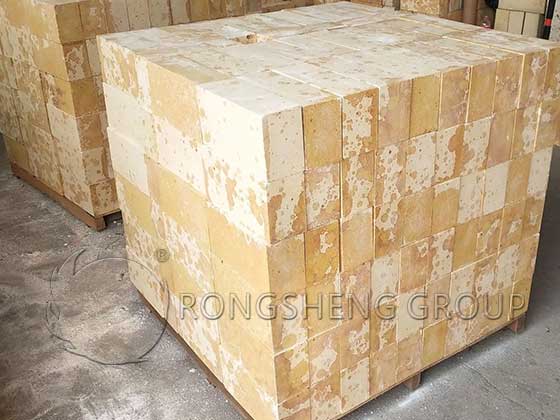
According to the phase transformation characteristics of quartz, the following stages should be controlled during firing.
- (1) The 500~700°C stage is the range where β-quartz transforms into α-quartz, and the volume expansion is 0.82%. Calcium hydroxide decomposes and undergoes a solid-phase reaction with the surface of quartz particles to generate CS.
- (2) In the range of 800~1000℃, a small amount of liquid phase can be generated under the action of a mineralizer. According to the measurement results of the electronic dilatometer, there is slight shrinkage at this stage, and the firing at this stage is relatively safe.
- (3) The temperature range above 1250℃ is the formation stage of metastable cristobalite. For quartz, there will be a volume expansion of about 15%, and the heating rate should be slowed down as much as possible. However, the amount of liquid phase generated will also gradually increase, which will slightly balance the huge volume effect.
- (4) 1350~1450℃ is the stage of massive crystallization of tridymite, and the transformation from α-quartz to tridymite will cause a volume expansion of 16.0%. However, quartz cannot be directly converted into tridymite but is converted into tridymite through metastable cristobalite. The volume effect of this phase change is not large, but the heating rate must also be controlled at this stage. This is because: ① The phase transformation of quartz into metastable cristobalite still occurs at this stage. ② Give sufficient time to ensure that the tridymite crystallization is as complete as possible. Therefore, the firing and holding time above 1350°C are very important for perfecting the formation of microstructure and obtaining the best high-temperature volume stability.
Depending on the production method and usage conditions, the performance requirements of silica bricks vary. Silica bricks for glass kilns are divided into three grades: 96A, 96B, and 95 according to physical and chemical performance indicators.
The appearance of silica bricks is specified as follows:
- ① When a crack crosses an edge, it is only allowed to cross one edge, and cracks across edges are not included in the calculation.
- ② The length of cracks on silica bricks parallel to the working surface shall not be greater than 1/5 of the length of the edge shared by the surface where the crack is located and the working surface.
- ③Cracks. Bricks with a single weight of no more than 20kg will be assessed according to the working surface crack index. Bricks with a unit weight greater than 20kg will be assessed for cracks on non-working surfaces.
- ④The technical conditions of bricks with a unit weight greater than 40kg shall be agreed upon by both parties.
China’s building materials industry standard (JC/T 616-2003 High-quality silica bricks for glass kilns) divides high-quality silica bricks for glass kilns into three grades based on unit weight and size. The unit weight ≤ 15kg is XBG-96. The unit weight 15kg ≤ 25kg is ZBG-96. The unit weight 25kg ≤ 40kg is DBG-96.
Its appearance has the following regulations:
- ① Cracks are only allowed to span one edge, and cracks across edges are not included in the calculation.
- ② The cross section is cracked. Bricks with a unit weight less than or equal to 15kg will be assessed according to the non-working surface crack index. Bricks with a unit weight greater than 15kg will be assessed according to the working surface crack index. However, cross-section spalling is not allowed to extend to the brick surface.
- ③ For bricks with a unit weight greater than 40kg, the technical conditions shall be negotiated between the supply and demand parties.
To purchase high-quality glass kiln silica bricks, please contact Rongsheng Refractory Materials Manufacturer. We can provide high-quality glass kiln silica bricks, zero expansion silica bricks, etc.



